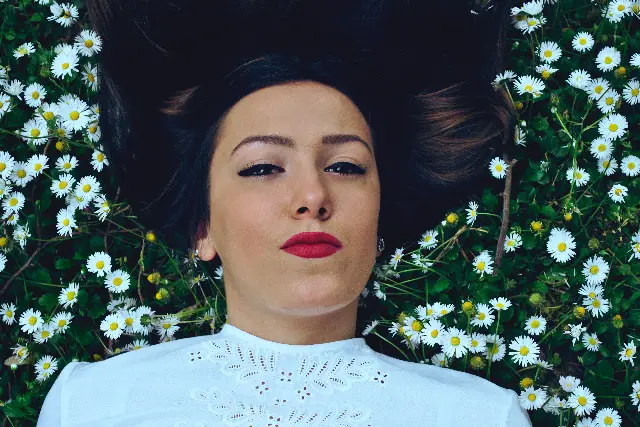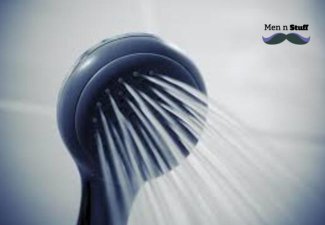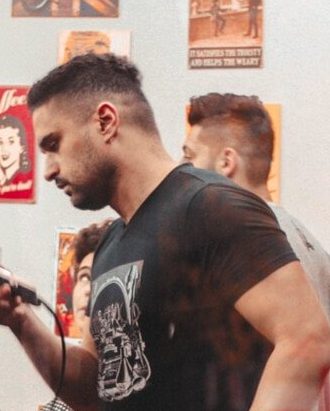Naturally, straight hair cannot permanently become curly without an external intervention like heat or chemical treatments. However, temporary methods like curling irons or perms can create the appearance of curls.
How Does Hair Become Curly or Straight?
We have three types of hair: straight, wavy, and curly. The shape of your hair follicle determines your hair texture. Those with straight hair have round follicles, while those with curly hair have oval or flattened follicles.
If you have straight hair, your follicles are shaped like tubes. This lets the natural oil produced by your scalp travel down the length of your hair shaft easily, resulting in smooth, shiny strands.
The shape of your follicle determines how tightly wound your strands are. This affects how easily your hair can be styled and how well it holds a curl. People with naturally curly hair have elliptical or flat-shaped follicles.
This article walks you through the factors that contribute to your hair turning from straight to curly. Keep reading!

Factors that Influence the Change of Your Hair from Straight to Curly
It’s essential to understand the shape of the follicle determines your hair texture. While the shape of your follicle can be influenced by genetics, age, and hormones – it’s primarily determined by your ethnicity.
So if you have naturally straight hair, it’s unlikely that you’ll be able to achieve perfect curls, no matter how much product you use or how often you curl your hair. However, a few factors can make your hair naturally turn from straight to curly, as explained below.
Hormones
It’s a common misconception that hair texture is determined solely by genetics. In reality, hormones play a significant role in dictating how our hair looks and feels. So, what happens when our hormone levels change
For some people, this can mean that straight hair becomes curly. While genetics are important, they don’t determine the texture alone. Hormones play a significant role as well.
There are several types of growth cycles for your hair follicles. These cycles affect the type of cells produced during each process, affecting the thickness and quality of your hair on different parts of your head.
The more anagen (growth) phases in one area, the thicker and more coarse the hair will be. The fewer anagen phases, the finer and less dense the hair will be.
Hormonal changes during puberty or pregnancy can alter your hair texture from straight to curly. The texture changes usually happen because of hormonal changes. It’s related to the levels of estrogen and testosterone in your body.
Age
While you may be born with a particular hair type, that doesn’t mean it will stay that way forever. Your hair texture can change as you age. You may go from having splendid, straight hair as a child to having thick, coarse locks when you become an adult.
Alternatively, if you now have naturally curly or wavy hair, your locks could turn into something completely different. What influences these changes as we grow older?
For starters, hormones significantly affect how our hair changes over time. Testosterone is one hormone that affects our strands. During puberty, girls get higher testosterone levels than boys, which is why many girls develop coarser hair during this stage. Women also produce more testosterone as they enter menopause, and their hormone levels drop—this means they may notice softer strands after they hit 50 years old or so.
However, not all hormonal fluctuations cause a change in the texture of our tresses—it’s what the hormone does to the scalp follicles that have the most effect on how our hair looks over time.
Genetics
When it comes to hair texture, genetics play a significant role. If both of your parents have straight hair, likely, you will too. But if one parent has curly hair and the other has straight hair, there’s a chance you could inherit either texture.
However, if you have dormant curl hormones, they might be triggered at some point, and your straight hair will become curly. For example, pregnancy often triggers new growth in wavy or curly textures.
Chemotherapy Treatment
While chemotherapy treats cancer, it can also have the side effect of changing hair texture. Some people who receive chemotherapy treatment find that their straight hair becomes curly or wavy.
Chemotherapy may cause this change in texture because it weakens and damages the roots of your hair, exposing them to frizziness and kinks. Chemotherapy treatments usually don’t cause a change in natural curl pattern (from spiral curls to tight curls), but some chemo patients have reported changes in curl pattern as well as a difference in thickness and length.

How to Turn Straight Hair to Curly Voluntarily
Do you have straight hair but have always dreamed of having curly locks? You’re not alone. Many women with straight hair envy those with curly hair. But what if we whisper that you can achieve the look of curly hair without using harsh chemicals or hot tools? That’s right – there are several methods you can use to get beautiful, bouncy curls without damaging your hair.
Here are the best ways to get curly hair without using a curling iron or a blow dryer:
- Put your wet hair in a bun on top of your head before bed and let it air dry overnight.
- Get an updo for formal occasions and then undo it later in the day for a more casual look.
- Twirl sections of your hair around a large barrel curling iron to create curl-damped waves.
- Use Velcro rollers and wrap them all over until you have them on every area of your head except for the bangs. Leave these rollers in for about 10 minutes before taking them out and brushing through the curls as they cool down and set in place!
The DIY Method
- Twist wet hair into two strands opposite each other and tie one end of each strand with a rubber band, then loosely braid them together, scrunching up pieces so they stick together to ensure they don’t unravel during the process. Wait 20 minutes or so (or as long as you want), remove the bands, and voila – curly hair!

Breaking Down the Percentage of People with Curl Hair
Natural curl hair is not commonplace. It is estimated that around 11% of the world’s population has curled hair. A case study on Asians reveals that 15% boast curly hair, 45% have straight hair, and 40% have wavy hair. Genetic polymorphisms and environmental factors primarily influence the trend.
How do I stop my hair from turning curly?
Curly hair is a beautiful natural asset for many, but sometimes, a sleek, straight style is desired. If your hair tends to become curly or wavy and you want to maintain the straight look, here are a few tips that will help you achieve your hair goals:
- Use a good quality hair straightening shampoo:
Using a straightening shampoo can help relax the hair cuticles and keep them smooth, resulting in fewer curls and waves. - Condition your hair properly:
Regular conditioning helps smoothen the hair strands and keeps them tamed, reducing their tendency to curl. - Blow-dry your hair:
If you allow your hair to air-dry, it may naturally curl or wave. On the other hand, blow-drying helps you control the drying process and keep your hair straighter. - Utilize straightening irons:
When used in moderation and with proper heat protection, hair straighteners can help maintain a straight hair look for longer periods. - Brush your hair regularly:
Regular brushing evenly distributes the natural oils in the scalp along your hair, preventing it from curling up. - Consider using a straightening serum:
Hair serums coat the hair strand providing a layer of protection against humidity – a major factor causing curliness. - Opt for a professional straightening treatment:
If you find that none of the at-home measures are effective enough, salon-grade treatments like keratin treatments or Japanese straightening can help keep the curls at bay for an extended period. - Eat healthily and stay hydrated:
Healthy hair begins from the inside. Ensure that you consume a balanced diet and drink plenty of water to strengthen your hair strands and avoid frizziness. - Use anti-frizz products:
These help keep moisture levels in check, preventing your hair from curling up due to humidity in the air. - Trim regularly:
Regular trims will eliminate split ends, which can exacerbate curliness.
Should Your Hair Care Routine Change if Your Hair Turns Curly?
The answer is yes. When your hair changes its texture from straight to curly or wavy, it’s time to reassess your hair care routine. Here are key reasons why you should alter your hair routine and some efficient ways to maintain your new curly locks.
1. Different Hair Structure
Straight hair and curly hair have completely different structures. Thus, they require varying types of maintenance. Curly hair tends to be more porous than straight hair, which means it can easily absorb moisture but also lose it rapidly.
2. Change in Natural Oils Distribution
The scalps of individuals with curly locks produce natural oils, but these oils often struggle to travel down the hair’s length due to the spiraling nature of curls. This results in the hair having dry ends and a greasy scalp.
3. Varied Frequency of Hair Wash
The frequency of washing curly hair should ideally be less than straight hair because shampoos can strip away natural oils. Hence, decreasing the frequency can help in maintaining the necessary oil in your locks.
4. Different Types of Hair Products
Straight hair and curly hair demand different kinds of care products. For curly hair, it’s preferable to use products that provide moisture, maintain curls, and reduce frizz.
5. Use of Different Tools
Hair tools that work for straight hair may not work for curls. For instance, instead of a brush, a wide-toothed comb or fingers are recommended for detangling curly hair to avoid breakage.
| Straight Hair | Curly Hair |
|---|---|
| Oils easily distribute from scalp to end | Oils struggle to travel down the hair |
| Can be washed frequently | Wash less frequently |
| Any type of comb/brush works | Ideally, use a wide-toothed comb |
| Most types of products work | Moisture-retaining products are needed |
Conclusion
If you have straight hair and wish to know if it can become curly, the answer is: maybe. The jury is still out on why people have naturally straight hair while others have naturally curly or wavy hair. But we know that the shape of your hair follicle plays a role in determining your hair texture. Factors such as hormonal change, aging, and genetics might change your hair naturally from straight to curly.
Alternatively, if you have straight hair, you were born with straight-haired follicles. But that doesn’t mean you can’t style your hair differently – including making it look curly. With ideal products and styling techniques, you can achieve any look you want. So go ahead and experiment until you find the perfect style for you.
References:
https://www.scienceworld.ca/stories/can-hair-change-straight-curly/
https://www.curlcentric.com/can-straight-hair-turn-curly/

